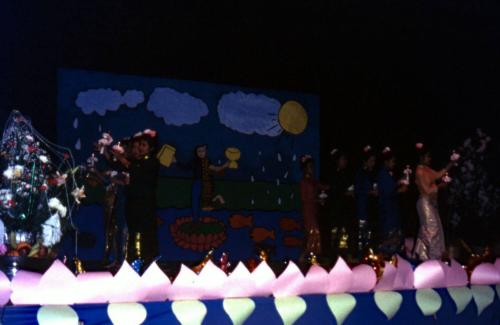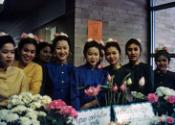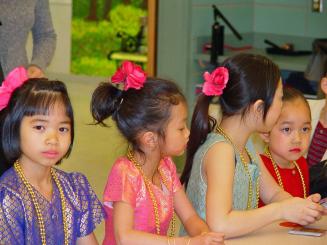Lao Saturday School New Year Presentation, 1995
SubjectPortrait of
Manola Sidara
(Laotian)
Date1995 April 8
Mediumpositive color film slides
ClassificationsGraphics
Credit LineConnecticut Cultural Heritage Arts Program collections
CopyrightIn Copyright
Object number2015.196.415.1-.19
DescriptionPhotographs from the Lao New Year presentation at Lao Saturday School at Jefferson School in 1995.
(.1-.2) Images of Lao Narthasin dance group performing onstage.
(.3) Image of students preparing for the presentation.
(.4-.6) Images of Lao Narthasin dance group performing onstage.
(.7) Image of students preparing for the presentation.
(.8) Image of Lao Narthasin dance group performing onstage.
(.9) Image of organizer Manola Sidara introducing the presentations.
(.10) Image of Lao Narthasin dance group performing onstage.
(.11) Image of students preparing for the presentation.
(.12) Image of students performing onstage.
(.13) Image of students preparing for the presentation.
(.14) Image of students performing onstage.
(.15-.16) Images of students playing in the cafeteria after the performance and hitting a piñata.
(.17) Image of Lao Narthasin dance group performing onstage.
(.18-.19) Images of the older students after the performance.
NotesSubject Note: Lao New Year is celebrated in Connecticut by members of the Lao community each April. Known as the Boon Pee Mai or the festival of the fifth month, this is a time of special meals and ceremonies lasting for several days. Traditionally, on the last day of the old year houses are cleaned and put in order as a symbolic activity intended to expel any bad spirits that may be hiding in the home. On the first day of the new year, people go to the temple where they wash the statues of the Buddha with perfumed holy water. The ceremonies ensure good health and prosperity in the new year. In Connecticut, Lao gather at temples for religious ceremonies, and hold special banquets that feature music and dance by local dance groups such as Lao Narthasin led by dance educator and chef Manola Sidara. Other events have included an annual presentation by the students of Lao Saturday School which ran for many years at Jefferson School in New Britain organized by Manola Sidara and Howard and Sue Phengsomphone. Many of these events are organized by the Lao Association of Connecticut. Many Lao New Year celebrations in Connecticut have involved guest artists from other cultural backgrounds and traditions. In 2008 and 2009, CHAP collaborated with WNPR’s acclaimed radio discussion show Where We Live to document several ethnic festivals across the state. Words and sound were woven together to create podcasts and audio slide shows that take viewers and listeners right to the festivals. This project visited and documented a festival at the Lao Temple in Morris.(.1-.2) Images of Lao Narthasin dance group performing onstage.
(.3) Image of students preparing for the presentation.
(.4-.6) Images of Lao Narthasin dance group performing onstage.
(.7) Image of students preparing for the presentation.
(.8) Image of Lao Narthasin dance group performing onstage.
(.9) Image of organizer Manola Sidara introducing the presentations.
(.10) Image of Lao Narthasin dance group performing onstage.
(.11) Image of students preparing for the presentation.
(.12) Image of students performing onstage.
(.13) Image of students preparing for the presentation.
(.14) Image of students performing onstage.
(.15-.16) Images of students playing in the cafeteria after the performance and hitting a piñata.
(.17) Image of Lao Narthasin dance group performing onstage.
(.18-.19) Images of the older students after the performance.
Subject Note: Lao Saturday School began operation in 1994, inspired by the community’s concern about its children forgetting or ignoring their parents’ culture. The Lao Association of Connecticut developed and managed the program. Because so many of its students were Lao, Jefferson Elementary School in New Britain opened its doors on Saturday mornings for classes in Lao language, history, and arts. At first serving only K -12 children, the School also offered classes in ESL and citizenship to adults who could attend with their children and grand-children. Teachers, who were professional educators and community leaders, divided the classes into age groups and subjects. For several years from January through May the school served about 65 children and a dozen adults from many of the Lao communities in central Connecticut. The School sponsored traditional festivals such as New Year each April, when the students performed the Lao dances, songs, and poems they learned.
Subject Note: The Lao Association of Connecticut (LAC) is a community-based non-profit formed in 1980 to provide assistance to Lao-Americans in areas of need such as cultural preservation, education, advocacy, translation, and access to services. Its Board of Directors is comprised of senior members of the Lao community, including educators and artists. LAC was instrumental in developing Lao Saturday School in collaboration with Jefferson School in New Britain, starting in 1994, and running for several years, offering classes in Lao language, history, and arts as well as ESOL and citizenship to adults. LAC sponsors an annual New Year Celebration in April that brings Laotians together from all over Connecticut, held for many years in New Britain and elsewhere in temples around Connecticut. LAC has also organized events and projects that serve the community; the group collaborated on the Southeast Asian Problem Gambling Project run by the Department of Mental Health and Addiction Services, as well as other health initiatives. LAC also worked with CCHAP and other Southeast Asian communities to recruit students and parent volunteers for after-school classes, involve students and teachers in community activities; and introduce artists from the other communities to each other.
Subject Note: The Lao Association of Connecticut (LAC) is a community-based non-profit formed in 1980 to provide assistance to Lao-Americans in areas of need such as cultural preservation, education, advocacy, translation, and access to services. Its Board of Directors is comprised of senior members of the Lao community, including educators and artists. LAC was instrumental in developing Lao Saturday School in collaboration with Jefferson School in New Britain, starting in 1994 and running for several years, offering classes in Lao language, history, and arts as well as ESOL and citizenship to adults. LAC sponsors an annual New Year Celebration in April that brings Lao together from all over Connecticut, held for many years in New Britain and elsewhere in temples around Connecticut. LAC has also organized events and projects that serve the community; the group collaborated on the Southeast Asian Problem Gambling Project run by the Department of Mental Health and Addiction Services, as well as other health initiatives. LAC also worked with CCHAP and other Southeast Asian communities to recruit students and parent volunteers for after-school classes, involve students and teachers in community activities; and introduce artists from the other communities to each other.
Biographical Note: Manola Sidara is a Lao dance educator and community activist whose life has been devoted to serving her community. Born in 1969 in Vientiane, Laos, Manola joined the National Dance School at the age of five, along with her sister. After her family fled Laos, she continued learning traditional dance with master dancer Sone Norasing in Colorado until moving to Connecticut in 1989. From her grandmother and aunts Manola learned to make pah khuane, the ornaments of bamboo leaves and flowers which are part of every Lao ceremony and celebration in both temple and home. She worked as a wedding consultant, organizing all the arrangements for traditional Lao weddings, and became known as a brilliant cake decorator. Manola helped to produce the exhibit The Ties That Bind: Southeast Asian Wedding Traditions at the Institute for Community Research (ICR) in 1995. In 1999-2000 she served as the Bilingual Program Assistant at Garfield School in Bridgeport, teaching ESOL, computers, and cultural awareness to elementary school children both Lao and Latino. Manola taught traditional dance at the Lao Saturday School in New Britain from its inception. With her high-school age students from the school, Manola formed the Lao Narthasin Dance Troupe, instructing the members in classical Laotian dance, folk dances of different ethnic groups in Laos, and traditional values and manners such as respectful behavior, honoring elders, and service to the family and community. The dance group, which has performed throughout Connecticut and Rhode Island at cultural centers and Lao temples, now includes a third generation of dancers. From 1998 to 2001 Manola was the New Britain Coordinator for the Urban Artists Initiative, a statewide training program run by the Connecticut Commission on the Arts and the Institute for Community Research. In 2001 Manola received an award from the Lao Association of CT at New Year for her work with the Lao Narthasin dancers and was selected as a CT Commission on the Arts Master Teaching Artist. In 2011 Manola coordinated the community oral history project After the Trauma: Holocaust Survivors and Laotian Refugees Confront the Past, displayed at the University of Hartford. Manola is also known as a master chef at East West Grille, her award-winning and beloved Lao-Thai restaurant on New Park Avenue in Hartford from 2000-2019, and the East-West Grille Food Truck. Manola is very active in assisting the Lao Temple in Morris, CT, with cultural programming, social service, and providing food for the monks and their ceremonies. For Manola, her tireless activities in dance, education, ceremonial decorations, and cooking all promote wellness, spirituality, bonding, and healing.
Biographical Note: Lao Narthasin of Connecticut is a group of young Lao-Americans who study and perform traditional folk and classical dances from the southeast Asian country of Laos. Most of these dancers were born in the United States to parents who immigrated here from Laos. They study Lao language and culture in special classes offered by the organization Lao-American Culture of Connecticut in cities such as New Britain, East Hartford, and Bridgeport where many Lao are now living. The Lao Narthasin dance group developed out of the Lao community's desire to preserve its heritage in America. Members of the company, who reside in cities throughout Connecticut, are trained by experienced instructors from notable Lao dance families. The founder of the group, Manola Sidara, is a Lao dance educator and community activist whose life has been devoted to serving her community. Born in 1969 in Vientiane, Laos, Manola joined the National Dance School at the age of five, along with her sister. After her family fled Laos, she continued learning traditional dance with master dancer Sone Norasing in Colorado until moving to Connecticut in 1989. Lao Narthasin now includes a third generation of dancers, and instructors include former students such as dancer Nancy Sayarath. Dance traditions in Laos are either classical, performed at the royal palace, or based in the rural folk cultures of the over sixty ethnic groups in Laos. Lao Narthasin performs both dance genres. Dances include the Hoyn Phon Yhia Welcome Dance where fresh flowers are offered to guests, and the Pow Lao Dance, featuring dancers from different tribal groups. The graceful movements made by the dancers reflect qualities of beauty, respect, and politeness so valued in Laotian culture. Hand gestures also tell stories in the dances, with subtle movements symbolic of spiritual beings such as deities ascending in the heavens. Many of the dances celebrate community festivals - the rice harvest, water festival, New Year, or the Fireworks Festival bringing prosperity and good fortune. Lao Narthasin wears many different authentic costumes appropriate to each special dance. The group often performs at festivals and ceremonies at temples in Connecticut and Rhode Island.
Subject Note: Connecticut was a major resettlement site for Southeast Asians in the 1980's. The Lao population numbers over 3000, living primarily in urban areas such as New Britain, Bridgeport, East Hartford, and Danbury and for a time in the 1990s-2007, in rural eastern Connecticut. While many Lao have found employment in factories, service industries, farming, and trades such as food, they continue to face barriers of language, lack of education, and lower income levels, all against a common backdrop of serious emotional wounds from the Viet Nam War era. Youth aged 10 - 19 years old have been by far the largest age group among Connecticut Southeast Asians. Maintaining young peoples’ awareness of heritage, culture, values, and language is a major goal of Lao leaders and parents. The Lao community sustains its traditional cultural practices in several ways. Several temples around the state provide gathering places where Buddhist monks and nuns offer spiritual services and cultural festivals. The largest temple is in Morris, where the resident monk Khoutavong has created exquisite Buddhist statues and traditional architecture with symbolic carvings, ornamentation, and shrines. Dancer and educator Manola Sidara developed and has directed Lao Narthasin, a traditional dance group now in its third generation of dancers. They perform classical, folk, and social dances that highlight cultural values such as respectful behavior and appreciation for elders. Manola also specializes in creating ceremonial decorations that express wellness, spirituality, and bonding during community celebrations, and she also promotes health and healing through her work as a master chef. The Lao Association of Connecticut formed in 1980 to unite the community and assist in economic development, cultural preservation, education, and health. For many years LAC offered classes in language, history, food and medicine, verbal arts, traditional music, and singing at Jefferson School in New Britain, and the group organizes several heritage festivals each year at the Morris temple that are attended by hundreds of Lao people. Other Lao community groups around the state also develop and present spiritual and cultural programs as well as health initiatives.
Additional audio, video, and photographic materials exist in the archive relating to this community and its artists.
Cataloging Note: This project was made possible in part by the Institute of Museum and Library Services MA-245929-OMS-20.
Status
Not on viewPenpa Tsering
2015 July 6
































